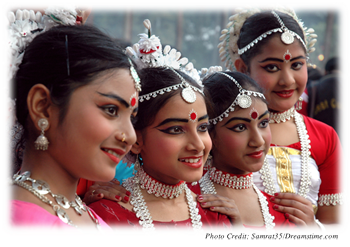
Chapter 1. Adolescence Around the World: Rites of Passage
Synopsis
Adolescence Around the World: Rites of Passage
Author
S. Stavros Valenti, Hofstra University
Pauline Davey Zeece, University of Nebraska – Lincoln
Synopsis

This activity explores the journey from childhood to adulthood, a journey that is often accompanied by various rites of passage. This activity presents a comparison of adolescent initiation customs of industrialized societies and those of developing societies, specifically the African Chokwe society.
REFERENCES
Areyvut (2007). Definitions and concepts. Retrieved May 17, 2007, from: http://www.areyvut.org/Resource/defcon.asp
Brown, B., Larson, W., & Sarawathi, T. (2002). The world’s youth – adolescence in eight regions of the globe. Cambridge, MA: Cambridge University Press.
CIA (2007). CIA World Factbook. Retrieved May 17, 2007, from: https://www.cia.gov/library/publications/the-world-factbook.
http://www.census.gov/popclock/
http://populationaction.org/topics/7-billion/
Jordan, M. (1999). Chokwe! Art and initiation among Chokwe and related people. African Arts, 33, 18-23.
Lloyd, C. (Ed.). (2005). The changing transitions to adulthood in developing countries. Panel on Transitions to Adulthood in Developing Countries. Washington, DC: The National Academy Press. http://books.nap.edu/openbook.php?record_id=11174&page=R1
MSN Encarta Online (2007). Rites of passage. Retrieved May 17, 2007, from: http://encarta.msn.com
Richter, L. (2006). Studying adolescence. Science, 312 (5782), 1902-1905.
United Nations. 2004. World Youth Report 2005: Report of the Secretary-General (A/60/61 – e/2005/7), p. 1. New York: United Nations. Retrieved May 17, 2007 from: http://www.unfpa.org/swp/2005/english/ch5/index.htm
Voices (2002). Quinceañera: A celebration of Latina womanhood. Voices. The Journal of New York Folklore, 28, 1. Retrieved May 17, 2007, from: http://www.nyfolklore.org/pubs/voic28-3-4/onair.html
Adolescence Around the World

Today’s generation of young people is the largest in human history. The latest population estimates have placed the world population at just over 7 billion, and nearly half of that population (around 3 billion) is under the age of 25. This significant adolescent-aged population makes this life phase worthy of examination and exploration.
Adolescence, the transition from childhood to adulthood, is one of the most challenging and complicated periods of life to describe, study, or experience. For several decades of psychological research, adolescence was thought to be an American cultural invention created during the late nineteenth century economic shift from manual to industrial labor. During this industrial revolution, increasing numbers of young people had no place in the changed workforce and had to depend on their parents until they could find employment. In a way, this generation of young people had acquired a prolonged dependency and a delay in taking on adult responsibilities creating a transitional period that came to be known as adolescence.
Contemporary scholars do not believe that adolescence is unique to industrialized or American societies for they have found evidence that a vast number of societies recognize adolescence as a time of growing up and as a transformation from childhood into adulthood (Brown, Larson & Sarawathi, 2002; Richter, 2006). While adolescence does seem to be a widely observed phenomenon, the details on how long it lasts or how it is celebrated varies depending on the culture, society, and specific circumstances of the individual and family.
Rites of Passage

In many instances, this transition from childhood to adulthood has characteristics of a formal or informal rite of passage. A rite of passage includes three distinct features that occur in the following sequence.
(a) separation from one’s old status as “child”
(b) a marginal or transitional state during which neither past nor future statuses or roles easily apply and the individual is transformed mentally and emotionally either by formal, socially-prescribed rituals or by a more informal, socially-derived set of experiences
(c) reintegration into society as an adult member with new rights and responsibilities
Formal and informal rites of passage help the developing adolescent to shed their pre-adolescent, child-like identity and to assume their post-adolescent, adult-like identity.
Rites of Passage Around the World

For many industrialized societies, there is no single, monolithic event that signifies the end of childhood or the beginning of adulthood. Instead, the passage from childhood into and through adolescence is informal involving more of a series of transitions that unfold gradually over a span of time and affect various aspects of a young person’s development. For example, in the United States, this passage through adolescence may be marked by some obvious celebrations, such as a graduation, turning 16, 18, or 21 years old, or a bah mitzvah/bat mitzvah, or by less-celebrated but still socially-valuable milestones, such as getting a driver’s license, going to a senior prom, becoming old enough to vote, or moving out of one’s childhood home.
For some other societies, transitions are more formal and may include culturally-defined and clearly specified initiation rites. These rites may include ceremonies, rituals, customs, and/or general practices that have their origins in religion, culture, folklore, history, and/or ancestral traditions. These rites of passage often act as means for passing down sacred, cultural, societal, communal, professional, and even sexual knowledge from one generation to another.
Rites of Passage Around the World (continued)

1.
What are some of the rites of passage that you or people you know have experienced? Explain how this experience(s) meets the definition of a rite of passage.
Chokwe Initiations: Mukanda and Ukule
Over one million Chokwe currently reside in Angola, Zambia, and the Democratic Republic of the Congo. Chokwe perform separate male (mukanda) and female (ukule or mwali) initiations that require considerable preparation and a period of seclusion from village life. These rites of passage mark the symbolic death of the initiates as children. For boys, initiation may last anywhere from a few months to more than a year. For girls, the initiation process may last anywhere from a few weeks to four months. During this process, young boys and girls go to initiation camps where they are educated on the principles of history, religion, cosmology, morality, and gender-specific social responsibilities. As part of these rituals, ancestral spirits are asked for guidance and protection and come to life through masked performers. These initiation ceremonies conclude with the newly initiated male and female adults returning to the village for a long night of dance and celebration.
|
|
In these two videos, you will see an overview on how Chokwe boys and girls experience their gender-specific rites of passage.

Male Initiation
|

Female Initiation
|
Summary

During adolescence, many facets of a person are changing and evolving. In many cultures, the teen years are shaped by rituals of separation, transformation, and reintegration. It is clear that adolescence is recognized worldwide as a significant life stage full of opportunities for growth and development. No matter whether the journey to adulthood is punctuated by various informal rites of passage or ushered in with a formal, traditional ceremony, some of the most profound physical, emotional, spiritual, intellectual, and even behavioral transformations in the life of a person occur in adolescence.
Assessment: Check Your Understanding

2.
1. Which of the following elements is a component of a rite of passage?
Assessment: Check Your Understanding

3.
2. Events in a child’s life must be formal and universally recognized to be considered rites of passage.
Assessment: Check Your Understanding
![In Latin America societies and communities, girls celebrate their fifteenth birthdays with a rite of passage known as a quinceañera ceremony.]](asset/157_E.png)
4.
3. Which of the following statements about the Chokwe initiation rites is FALSE?
Assessment: Check Your Understanding

5.
4. What role do ancestors play in the Chokwe initiation ceremonies? Is there an ancestral component to any of the initiations or rites of passage that you are familiar with and described on screen 5?
Congratulations! You have completed this activity.Total Score: x out of x points (x%) You have received a provisional score for your essay answers, which have been submitted to your instructor.